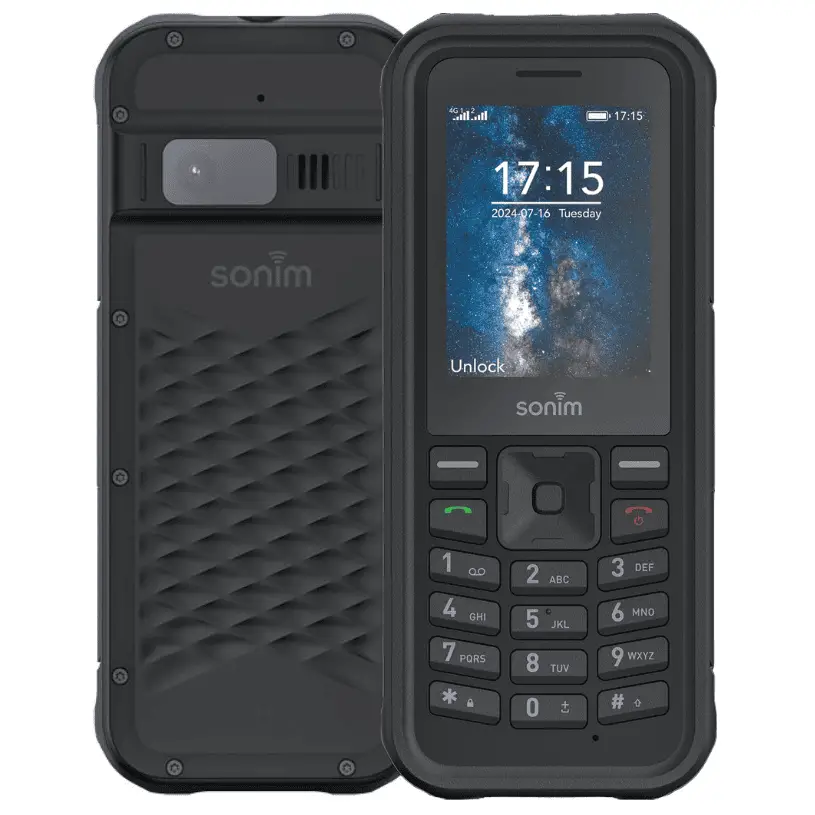

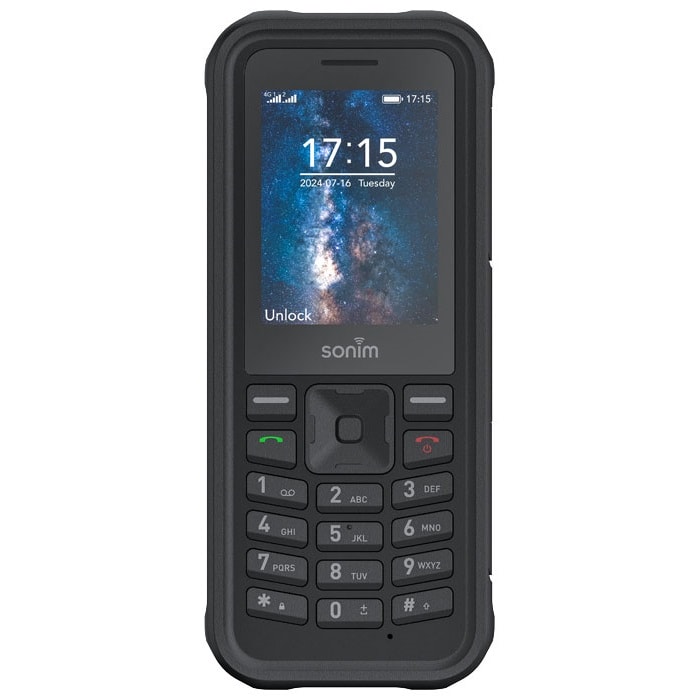
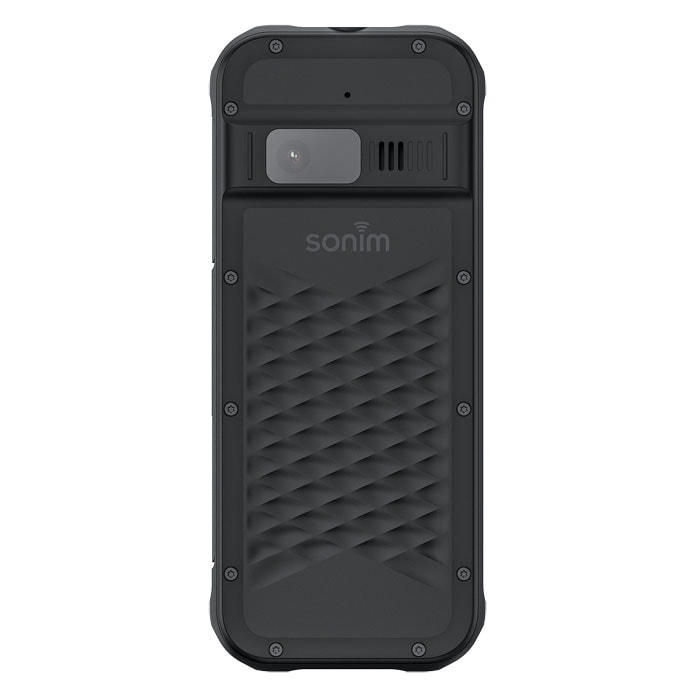
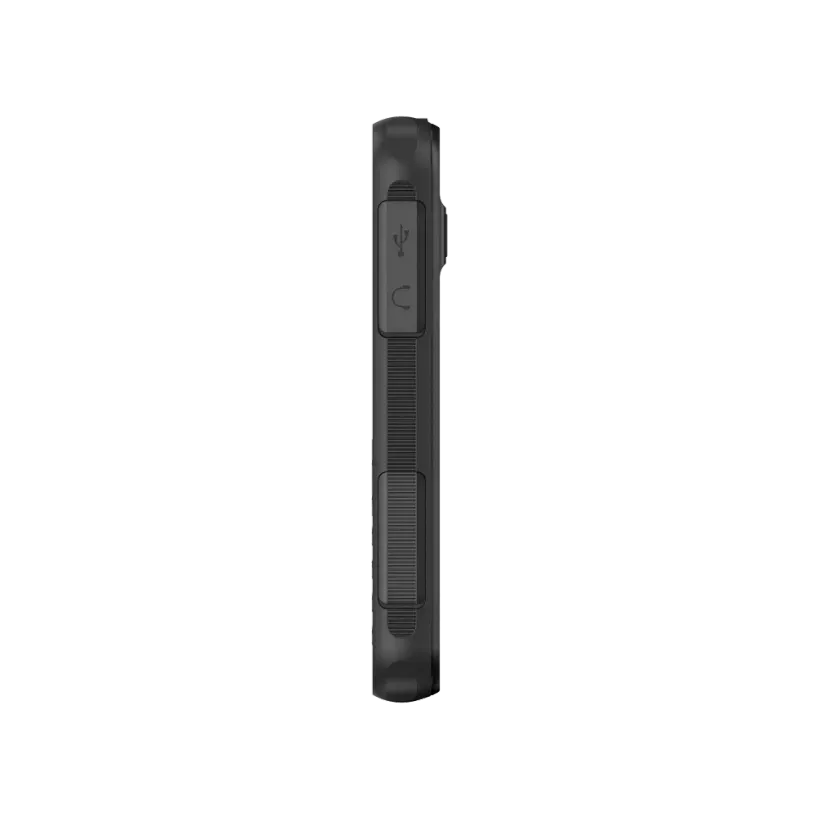

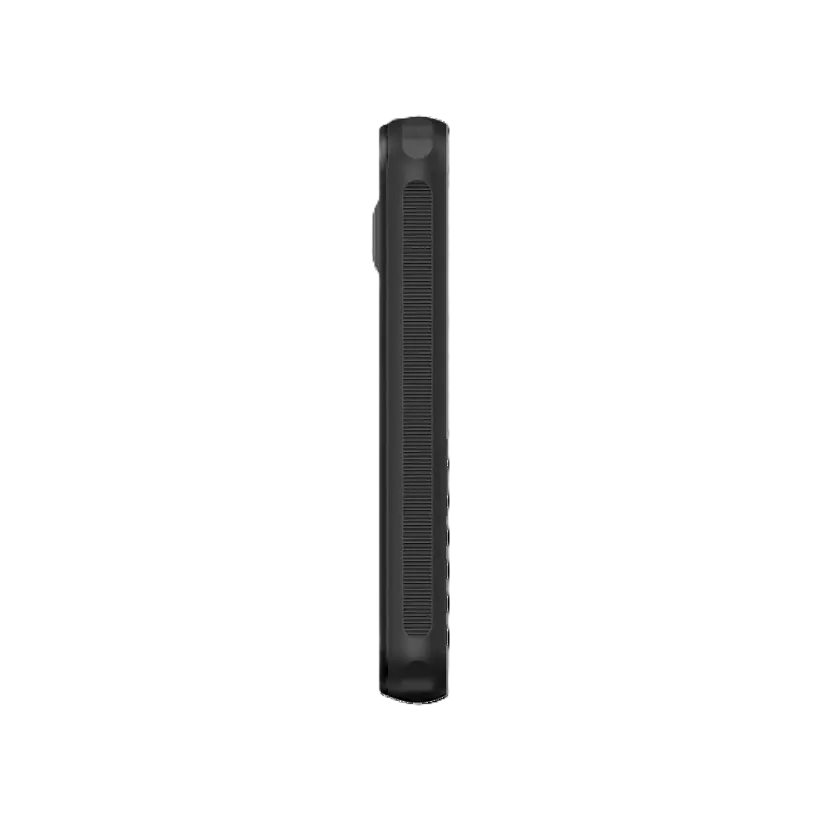
This is the Sonim XP100, a rugged 4G feature phone designed for tough environments. It has dual Nano SIM slots and supports 2G, 3G, and 4G networks, covering a wide range of LTE bands.
The phone measures 145 × 62 × 16.2 mm, weighs 165 grams, and meets IP68/IPX9K and MIL-STD-810H standards, offering protection from water, dust, and drops up to 1.8 meters. The operating temperature ranges from -20°C to +55°C, making it suitable for harsh work environments.
The phone features a 2.4-inch TFT display with 240 x 320 resolution, protected by scratch-resistant Corning Gorilla Glass. It is powered by a 1.0GHz single-core Unisoc T127 chipset and runs Sonim’s Mocor OS. The device has 64MB of RAM, 128MB of internal storage, and supports microSD cards up to 128GB.
The XP100 includes a 2MP rear camera but has no front camera. Connectivity options include Bluetooth 5.0, FM radio (wired), a USB Type-C 2.0 port, and a 3.5mm headphone jack.
It does not include GPS or any sensors. A dedicated torchlight is located at the top of the phone, and the 1800mAh battery is removable. The device is available in black and has a loudspeaker on the rear for audio output. The table below contains the full specifications of the Sonim XP100 4G.
| Launch This refers to the date when this device was officially introduced into the market. | Announced 2024, September 10 / Available 2024, October 24 |
| Brand / Model These are key identifiers that indicate the manufacturer or company that produces this smartphone, and the specific model of the phone. | Sonim / XP100 |
| 2G Bands 2G refers to the second generation of cellular technology and includes various frequency bands for basic voice and text communication. | GSM Band 850 / 900 / 1800 / 1900 - SIM 1 and 2 |
| 3G Bands 3G refers to the third generation of cellular technology, encompassing different frequency ranges for faster data speeds, mobile internet, and multimedia capabilities. | UMTS Band 2(2100 MHz), 2(1900 MHz), 5(850 MHz), 8(900 MHz). |
| 4G Bands 4G refers to the fourth generation of cellular technology, operating in specific frequency bands to provide significantly faster data speeds, supporting high-definition video streaming and advanced applications. | LTE Band 1, 3, 7, 8, 20, 28, 38, 40, 41 |
| Ruggedity This indicates the device's durability and ability to withstand harsh conditions or impacts. It is a very popular term used with tough or rugged phones. IP68/IP69K are international ratings that measure a smartphone's resistance to dust and water. MIL-STD-810H is a military standard that sets criteria for the environmental and durability testing of electronic devices. It means this device has undergone various tests to demonstrate its resilience in challenging conditions, such as extreme temperatures, humidity, vibration, and shock. |
IP68/IPX9K and MIL-STD-810H - Water / Dust / Drop proof from 1.8m - Operating Temperature -20°C to +55°C |
| Dimensions / Weight: This refers to the physical size and weight of the device, measured in millimeter (mm) and grams (g) respectively. | 145 × 62 × 16.2 mm / 165 grams |
| SIM SIM stands for "Subscriber Identity Module." It is a small card, typically inserted into a slot in a mobile phone, that contains important information for connecting the device to a mobile network. SIM cards can come in various sizes, including standard SIM, micro SIM, nano SIM, or even electronic (eSIM), depending on the phone's design. | Dual Nano SIMs |
| Screen Display refers to the screen or visual interface of the device. It includes details such as screen size, resolution, and technology (e.g., LCD, OLED, AMOLED). | 2.4-inches / TFT / 167 PPI |
| Resolution Screen Resolution refers to the number of pixels that make up the display screen and is typically expressed as a combination of horizontal and vertical pixel counts (e.g., 1920 x 1080, 2560 x 1440, or 3840 x 2160). The screen resolution determines the level of detail and sharpness of the visual content displayed on the smartphone's screen. Higher resolutions generally result in crisper and more detailed images and text | 240 x 320 resolution |
| Features Camera features encompass various functionalities and capabilities that enhance the device's photography and videography experience. These features can include Optical Image Stabilization (OIS) Panorama, HDR, Ai Mode, Night Mode, Portrait Mode, etc. | Scratch Resistance with Corning Gorilla Glass |
| OS This is the Operating System. It refers to the software platform that runs on the smartphone and manages the device's hardware and software resources. Common smartphone operating systems include Android (developed by Google), iOS (developed by Apple). | Sonim Feature OS (Mocor OS) |
| Chipset This refers to the integrated circuit that serves as the device's central processing unit (CPU). It plays a pivotal role in the smartphone's performance, speed, and energy efficiency. | Unisoc T127, Single core, 1.0GHz |
| Memory This encompasses two components: storage capacity and RAM (Random Access Memory). Storage capacity, typically measured in gigabytes (GB) or terabytes (TB), dictates how much internal space is available for apps, files, and media storage. RAM, measured in gigabytes (GB), is temporary memory crucial for multitasking and app performance, with more RAM generally leading to smoother operation and faster task-switching capabilities. | 64MB RAM + 128MB ROM / + 128GB SD-card |
| Main The main camera, also known as the rear camera, is the primary camera on the back of the smartphone. It is typically used for capturing photos and videos in various scenarios and is often the more powerful and versatile camera on the device | 2MP single rear camera / No LED Flash |
| Selfie The selfie camera, also known as the front-facing camera, is the camera on the front of the smartphone, primarily used for capturing selfies and video calls | None |
| Features Camera features encompass various functionalities and capabilities that enhance the device's photography and videography experience. These features can include Optical Image Stabilization (OIS) Panorama, HDR, Ai Mode, Night Mode, Portrait Mode, etc. | VGA |
| Connectivity This encompasses the device's ability to connect and communicate with other devices and networks. It includes features such as cellular connectivity, Wi-Fi, Bluetooth, NFC (Near Field Communication), and USB connectivity options. | Bluetooth 5.0 / FM Radio / Type-C 2.0 / 3.5mm audio jack |
| Navigation Navigation refers to the device's ability to determine and display location information and provide directions to users. This functionality is usually powered by Global Positioning System (GPS) technology. | None |
| Sensors This refers to the various built-in sensors that enable the device to gather information from its environment and interactions. Common sensors found in rugged smartphones may include fingerprint sensor, light sensor, barometer sensor among others. | None |
| Battery This section refers to the device's power source and its related specifications. This typically includes details such as the battery capacity, measured in milliampere-hours (mAh) or watt-hours (Wh), and it charging details. | Li-Ion 1800mAh, removable |
| Others This is a catch-all category that includes various additional features, specifications, or capabilities that don't fall under the major categories like display, camera, memory, or connectivity. |
Dedicated Torchlight (top) Single loud speaker Color: Black |
These specifications were entered manually, hence we CANNOT guarantee 100% accuracy. Also, that your device is listed on this website DOES NOT call for reckless usage! It is crucial to exercise due diligence, as we cannot be held responsible for any damage to your device due to overconfidence in it built quality.
Leave a Reply